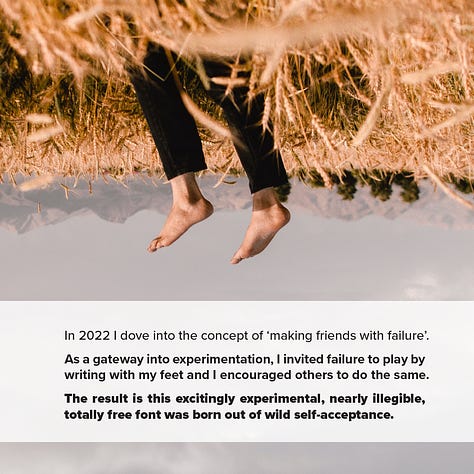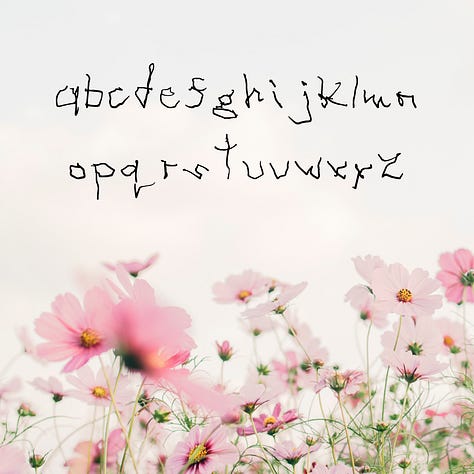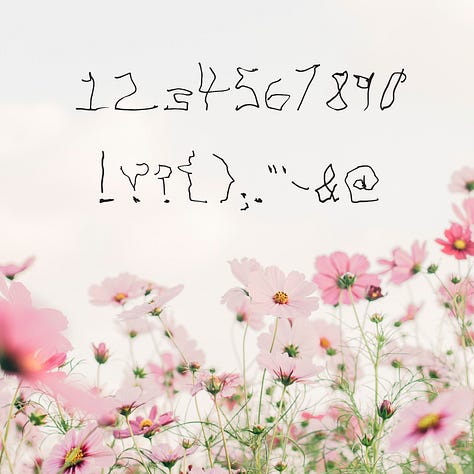Making Friends with Failure
Failure is part of the process but it doesn't need to be part of our identity
🐈 😑 ❌
Have you ever found yourself watching an endless stream of ridiculous cat videos on YouTube while procrastinating?
Yep, me too.
While this isn’t distinctly about procrastination, it’s important to address a big ‘WHY’ behind procrastination. We often procrastinate because we’re fearful.
We’re fearful of not knowing where to start.
We’re fearful of not knowing where we’re going.
We’re fearful of not knowing how or where or when to end.
We’re fearful of FAILURE.
📑 🔬 📖 💭 📑
The humble Post-it Note is an incredible creative tool. It should be acknowledged that the glue on the back of Post-it Notes was considered a failure when first conceived. According to 3M, the story goes something like this…
A 3M scientist, Dr. Spencer Silver, was trying to develop a stronger, stickier adhesive when he instead created the opposite. He discovered an adhesive that stuck lightly to surfaces and was able to be removed with ease. He failed, but… he failed forward.
He believed that his idea had potential and it wasn’t until years later when fellow 3M scientist, Art Fry, was frustrated with the little scraps of paper he used to bookmark hymns during choir practice that would all fall out before Sunday’s service.
Around the same time, Fry remembered a seminar he’d attended about Dr. Silver’s lightly sticky microsphere adhesion technology, finding a use-case for the ‘failed technology’.
And the rest – as they say – is history!
❌ 🏭 🪜 🚀 🙅 🎪
Let’s define ‘failure’.
According to Oxford Languages, the definition is “lack of success” and “the omission of expected or required action”.
Over the past 100+ years, our industrialist society has told us that success lies in conformity and compliance.
In this model, success looks like climbing a predictable ladder to the top. It’s hard to be okay with failure if we’re taught that there’s a right and a wrong answer, the former enabling a clear and linear path upward.
As Seth Godin describes in his book, The Icarus Deception: How High Will You Fly?, school has been transformed from a place of inquiry, to a place of standards. The industrialist age told us that there are answers and that you need the answers to succeed.
Seth believes that in our industrialized systems we’ve been un-teaching people how to innovate, express themselves and take initiative. In essence, school has been un-teaching students how acknowledge their ‘authentic selves’, instead relying on their ‘conforming selves’.
In the shifting age of our connection economy (represented by constant disruption, rapid innovation and the democratization of tools), success looks different. Success belongs to those who are bold and creative and brave and connect and challenge the status quo.
🧅 📦 🌟 👐 🤔
I love all of this and I wish to peel back this reimagining of success one layer deeper.
Most examples of success are framed around outputs. Am I creating work that measures up to others? Am I creating work that is objectively “good”?
What if we reimagined success to not only reflect outputs, but also to include inputs? Curiosity, risk-taking, vulnerability, quantity of ideas (not just quality) and more?
While most traditional measures of success rely on outputs, we are not in control of these outputs (including how others will perceive them) once they leave our hands. In contrast, measures of success that rely on inputs are inside our control; our processes and feelings around those processes.
How might this shift the way we think about and define success in our own work?
😩 😳
Even still, there’s something hugely emotionally vulnerable about the whole idea of producing creative work that might very well fail by standard measures of success.
How do we cope with the emotional realities of doing creative work that is such a reflection of our own identities?
How do we overcome the feelings of shame that can accompany something not going to plan?
How do we make friends with failure?
👥 🛝
What I’ve found to be true is that making friends with failure is a two step process: first, establishing a healthy boundary with failure and then — and only then — inviting failure to play.
⛲ 💻 👻 ✅ ❎ 🪙
For inspiration as to how we might get started, let’s look to Ancient Greece and Ancient Rome.
In her 2014 TED Talk viewed more than 21 million times, author Elizabeth Gilbert shares the way that the people of Ancient Greece and Ancient Rome believed creativity to work.
They believed that creativity was a divine spirit who visited human beings and gifted them with their creative ideas. Therefore, they didn’t believe that someone was a genius, but rather that they had a genius.
This helped them manage the emotional risk involved in creative work. Afterall, if they were wildly successful, they couldn’t take all of the credit because their genius was at least partly involved.
If they were wildly unsuccessful – if they failed – they needn’t take all of the blame because their genius was at least partially responsible.
What if success (‘genius’) and failure are not two sides of the same coin, meaning only one or the other is possible; what if they are the same side of the same coin, failure being an integral part of success? Failure existing as part of the process but not needing to exist as a part of our identity?
✋ 👀 👂👃 👄
How do you sense Failure?
What does Failure feel like?
What does Failure look like?
What does Failure sound like?
What does Failure smell like?
What does Failure taste like?
Examples from those I’ve asked include that Failure looks like a shadowy figure lurking in the darkness, Failure sounds like nails on a chalkboard and Failure tastes metallic and off-putting.
Understanding how we individually experience the sensations of Failure can help bring awareness when it pays a visit, so we may reaffirm its separateness from us as human beings.
🚶🎒 ⛶
Because while Failure may choose to walk alongside us in our creative pursuits, we are not Failure.
If we’re able to differentiate between ourselves and Failure – acknowledge that it’s part of the process but not a fundamental part of our identity — we shed the weight of carrying our failures with us everywhere we go.
And what fills this newly-found space between ourselves and Failure? A world of opportunities, brimming with greater self-confidence.
😠 👯 🛝
But all of this makes Failure seem really bad. For all of the emotional turmoil that Failure causes, it’s also misunderstood. While often seen as an enemy upon first meeting, making friends with Failure can allow us to grow in unexpected ways.
Knowing this, what if we welcomed Failure with open arms, asking it to play with us in our creative endeavours? Failure then becomes a co-creator, a confidant and a valued member of the team.
I invite you to invite Failure to play.
✍ ✍ 👟
Please grab something to write with and something to write on.
Using your dominant hand, simply write your name.
Consider how this feels. Perhaps it’s easy? Comfortable? Familiar?
Now please switch hands and now use your non-dominant hand to write your name.
How does this feel? Uncomfortable? Awkward? Clumsy? Great! A tiny experience of Failure.
Let’s get weird! Please remove one shoe. 😉
Place your pen or pencil between your toes and write your name. You will be bad at it. It will feel like Failure. But as we know we are not Failure and we’ve invited it to play so let’s be good collaborators and welcome it into the process.
Note: If writing with your feet feels like a little too weird, I encourage you to write your name with anything other than your hands. For example, you can place your pen in the crook of your elbow or in your mouth and try to write your name. The effect will be the same while keeping your feet planted firmly on the ground.
🎢 😬 📍🚩 🙈
Making friends with Failure means that we’re exploring uncharted territory, open to whatever is on the other side. This will, undoubtedly, feel a little uncomfortable (not unlike we just experienced). So how do we make it feel easier to fail?
I have 3 ideas:
Break explorations into numerous small, low-stakes chunks, each with the opportunity to succeed or fail and then learn from either outcome.
Do it more often. Because small chunks = lower risk, get into the habit of inching outside of your comfort zone on a regular basis. If you make 100 tries, for example, you might succeed 40, 50, 60, 70, 80 or more times. That’s HUGE and far more wins than had you never tried at all (and think of all the figuring out along the way!).
If the word ‘failure’ still feels unsettling, feel free to use the word to ‘surprise’ instead. May this new choice of word remind you of all the possible greatness that can come from your experimentation.
🌎 🚪 📑
The act of failure can help us understand ourselves and the world around us far better than if we’d never experienced it.
Failure helps drive innovation forward in ways that ‘getting the answer right’ every time will never allow.
Failure separate us from the machines.
Failure makes us human.
Get curious, experiment, try, do, surprise, fail, observe, acknowledge, embrace, learn, grow and then do it all over again. This is what happens when we make friends with Failure, redefining success in the process.
Much like the un-sticky Post-it Note glue, you never know when experimentation that leads to what’s first considered a failed attempt can spark a whole new direction of inquiry and change the world in the process.
💭 🥳 💁
And I’m so grateful to the many incredible people helping to normalize Failure.
For example, author Brad Montague (The Enthusiast by Brad Montague and Becoming Better Grownups) holds Fail-a-brations to celebrate moments of failure and what we’ve learned from them.
Improv artists fail all the time and do it so beautifully. Their entire process is about vulnerability, trying, receiving feedback and then ‘failing forward’ into the show the next night. Night after night after night.
It’s when we can acknowledge failure as a community that we can collectively unravel our complex conditioning with success, unlearning that ‘we’re only as good as our outputs’.
We can uncouple work and worth.
📺 💖 💰 🔄 😹 😻
I’d like to end by sharing one final story of failure in the digital media realm: YouTube.
YouTube was first conceptualized as an Internet dating site, with the tagline ‘tune in, hook up’. As detailed in his 2007 convocation speech (naturally, found on YouTube), one of the founders, Jawed Karim, shared this initial vision for the pioneering website.
After 5 days and not a single singles video uploaded to the site, the founders took to Craigslist and offered to pay women $20 to create and upload a video (…and they didn’t get a single reply).
The founders believed that their video sharing idea had potential so while they initially faced failure, they stuck with it and pivoted to become one of the most popular websites on the Internet.
And without YouTube, there wouldn’t be the same ridiculous cat videos to watch while procrastinating out of fear of failure.
And maybe we can learn from these cats. We can appreciate their unapologetic desire to be curious and experiment and try, taking the leap even if failure is a possibility…
And sometimes you take the leap and magic happens…
Go forth and make friends with Failure!
NEW Free Font: Friends with Failure!
Introducing a heart-centred, foot-centred experimental font co-created with failure. By Diana Varma
Font highlights:
Uppercase & lowercase letterforms
Numerals 0-9
Standard punctuation
Alternate characters by the alternate foot
Even includes an Interrobang












